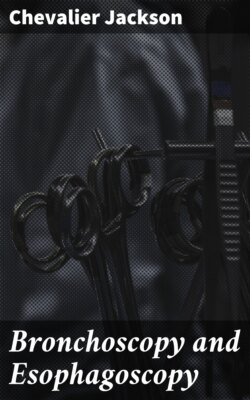Читать книгу Bronchoscopy and Esophagoscopy - Chevalier Jackson - Страница 7
На сайте Литреса книга снята с продажи.
THE ESOPHAGUS
ОглавлениеA few of the anatomical details must be kept especially in mind when it is desired to introduce straight and rigid instruments down the lumen of the gullet. First and most important is the fact that the esophageal walls are exceedingly thin and delicate and require the most careful manipulation. Because of this delicacy of the walls and because the esophagus, being a constant passageway for bacteria from the mouth to the stomach, is never sterile, surgical procedures are associated with infective risks. For some other and not fully understood reason, the esophagus is, surgically speaking, one of the most intolerant of all human viscera. The anterior wall of the esophagus is in a part of its course, in close relation to the posterior wall of the trachea, and this portion is called the party wall. It is this party wall that contains the lymph drainage system of the posterior portion of the larynx, and it is largely by this route that posteriorly located malignant laryngeal neoplasms early metastasize to the mediastinum.
[58] [FIG 46.—Esophagoscopic and Gastroscopic Chart
BIRTH 1 yr. 3 yrs. 6 yrs. 10 yrs. 14 yrs.ADULTS 23 27 30 33 36 43 53 Cm. GREATER CURVATURE 18 20 22 25 27 34 40 Cm. CARDIA 19 21 23 24 25 31 36 Cm. HIATUS 13 15 16 18 20 24 27 Cm. LEFT BRONCHUS 12 14 15 16 17 21 23 Cm. AORTA 7 9 10 11 12 14 16 Cm. CRICOPHARYINGEUS 0 0 0 0 0 0 0 Cm. INCISORS FIG. 46.—The author's esophagoscopic chart of approximate distances of the esophageal narrowings from the upper incisor teeth, arranged for convenient reference during esophagoscopy in the dorsally recumbent patient.]
The lengths of the esophagus at different ages are shown diagrammatically in Fig. 46. The diameter of the esophageal lumen varies greatly with the elasticity of the esophageal walls; its diameter at the four points of anatomical constriction is shown in the following table:
Constriction Diameter Vertebra
Cricopharyngeal Transverse 23 mm. (1 in.) Sixth cervical
Antero-posterior 17 mm. (¾ in.)
Aortic Transverse 24 mm. (1 in.) Fourth thoracic
Antero-posterior 19 mm. (¾ in.)
Left-bronchial Transverse 23 mm. (1 in.) Fifth thoracic
Antero-posterior 17 mm. (¾ in.)
Diaphragmatic Transverse 23 mm. (1 in+) Tenth thoracic
Antero-posterior 23 mm. (in.—)
For practical endoscopic purposes it is only necessary to remember that in a normal esophagus, straight and rigid tubes of 7 mm. diameter should pass freely in infants, and in adults, tubes of 10 mm.
The 4 demonstrable constrictions from above downward are at 1. The crico-pharyngeal fold. 2. The crossing of the aorta. 3. The crossing of the left bronchus. 4. The hiatus esophageus. There is a definite fifth narrowing of the esophageal lumen not easily demonstrated esophagoscopically and not seen during dissection, but readily shown functionally by the fact that almost all foreign bodies lodge at this point. This narrowing occurs at the superior aperture of the thorax and is probably produced by the crowding of the numerous organs which enter or leave the thorax through this orifice.
The crico-pharyngeal constriction, as already mentioned, is produced by the tonic contraction of a specialized band of the orbicular fibers of the lowermost portion of the inferior pharyngeal constrictor muscle, called the cricopharyngeal muscle. As shown by the author it is this muscle and not the cricoid cartilage alone that causes the difficulty in the insertion of an esophagoscope.
